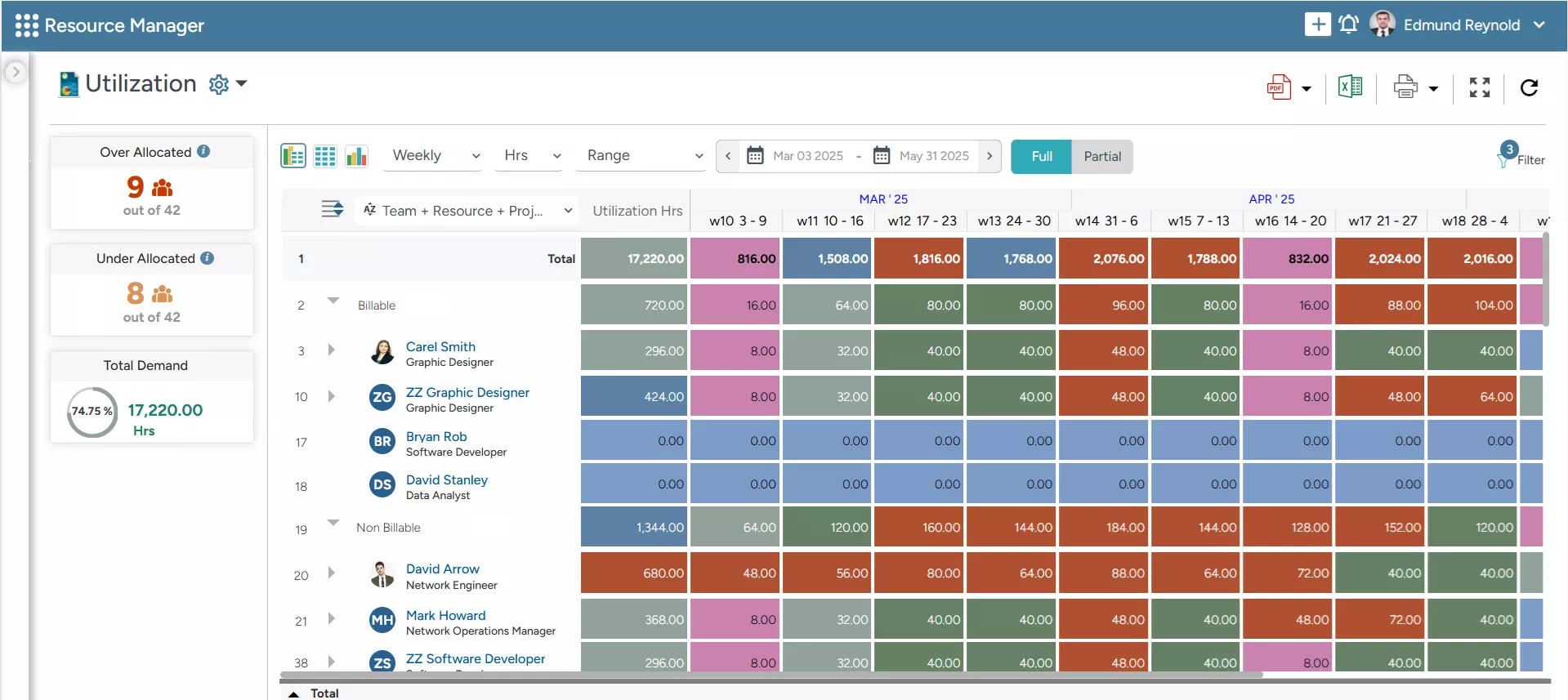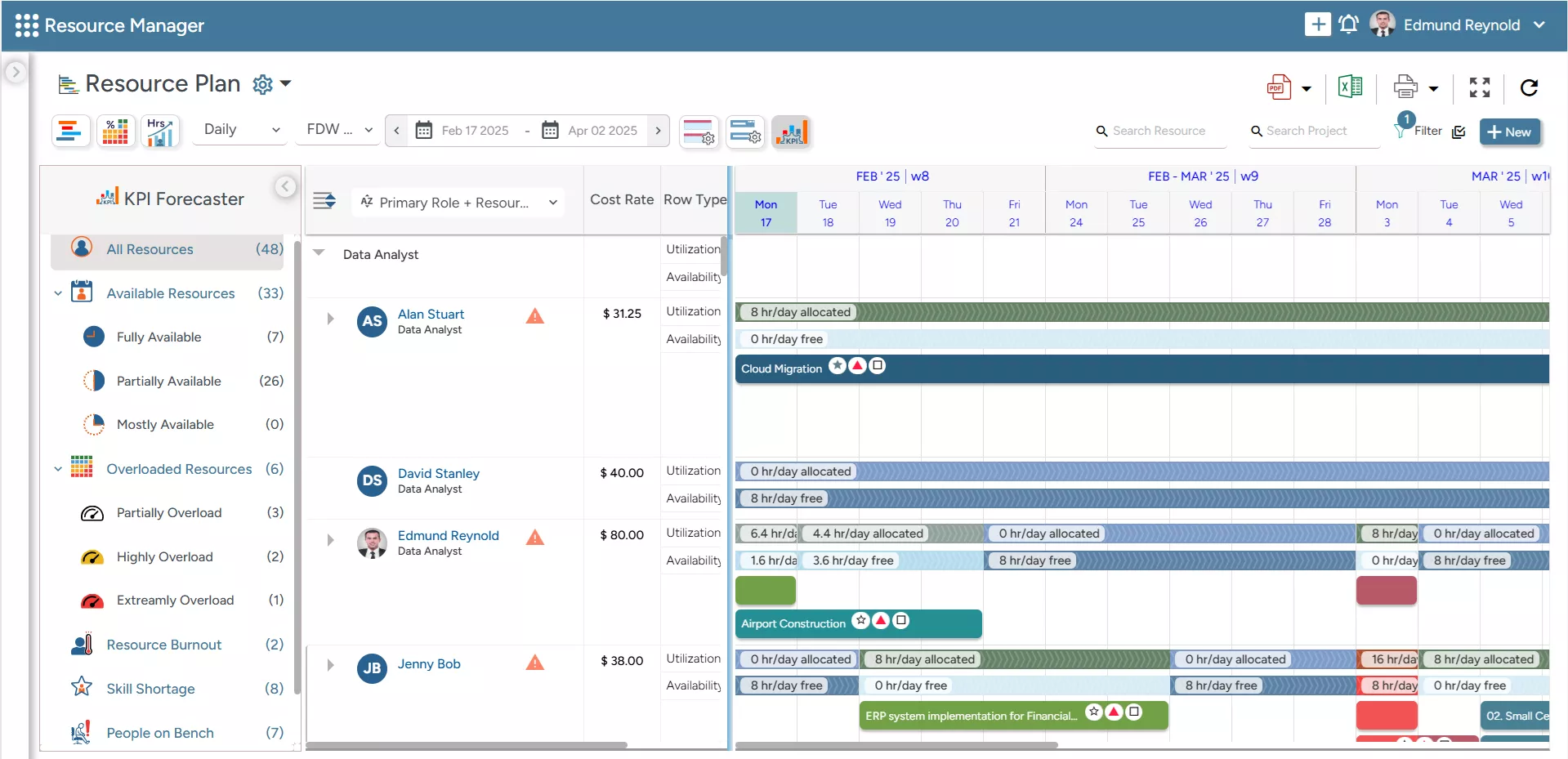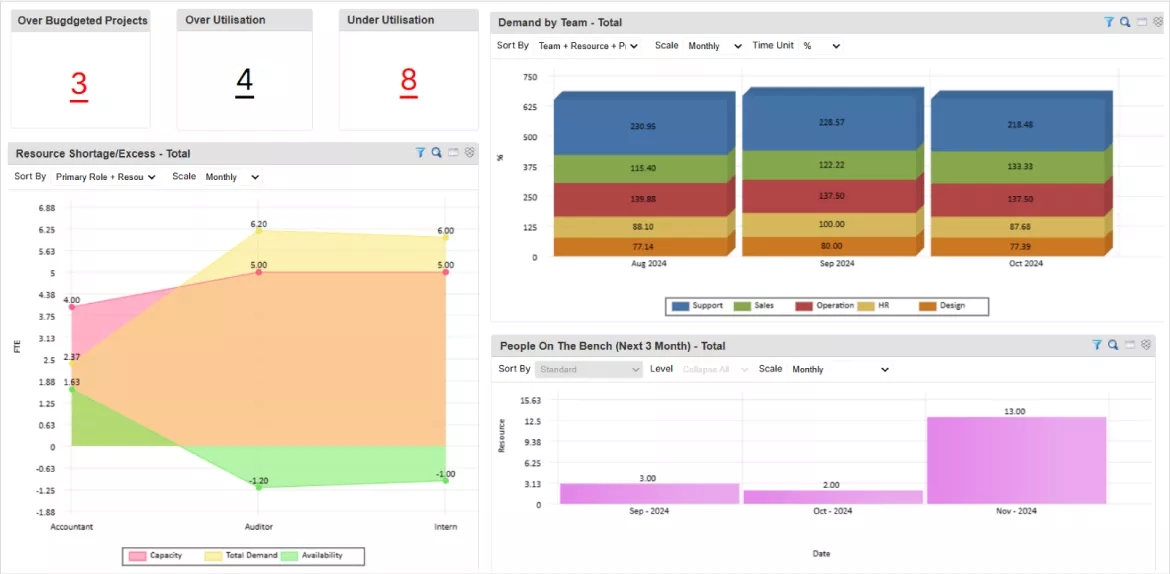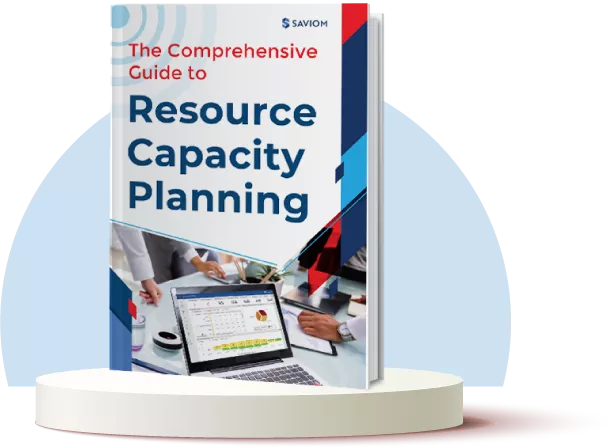Are you facing scheduling conflicts such as double bookings or last-minute changes?
Are you struggling to start projects on time due to a lack of visibility into resource schedules?
Has resource under/overloading become a common phenomenon in your organization?
If you constantly struggle with these challenges, you must rethink how you plan your project resources. After all, resource availability isn’t just a checkbox for project managers—it is the cornerstone for successful project planning and delivery.
To find and allocate the right resources to the right projects, managers must extensively analyze the internal workforce. Furthermore, they need insights into key resource metrics such as availability, skills, future bookings, etc.
However, factors such as the lack of centralized resource visibility, absence of up-to-date skill matrix, misalignment in resource and project calendar, etc., make this process more daunting. Therefore, managers need to adopt appropriate measures and tools to streamline resource availability tracking for successful project initiation and delivery.
In this blog, we will explore the fundamentals of resource availability in project management and how organizations can track it.
Let’s take a deep dive into the definition of resource availability.
What is Resource Availability?
Resource availability refers to the number and type of resources that are currently available to undertake new tasks or projects. It provides insight into critical attributes such as current resource capacity, existing skills and competencies, tools, and available budget.
In other words, if we have to define resource availability, it provides an overview of the resource schedules and a clear picture of who’s available to take up the tasks. A resource can be partially or fully available and must be utilized to its total capacity. Based on this information, managers can plan and allocate the project tasks in advance, avoiding last-minute hiccups.
Now that the definition of resource availability is clear, let’s understand how to measure it.
Resource Availability Formula
The formula for calculating resource availability is:
| Resource Availability = (Total Available Resources / Total Required Resources) X 100% |
|---|
In this formula:
- Total available resources represent the quantity or capacity of resources that are currently accessible or ready for use.
- Total required resources refer to the quantity or capacity of resources necessary to complete a project — also known as resource demand.
Now, let’s understand the concept of resource availability with an example.
Resource Availability Example
To better understand resource availability, let’s consider an example:
An IT firm has a cybersecurity project in the pipeline. The project manager starts the planning process once the project reaches the probability stage. Once the manager has clarity about project scope and other critical details, they assess the resource requirements in terms of skills, capacity, cost, and duration.
If the IT firm has adequate resources, the team can start working immediately without delays. However, if the required skills are missing, the project manager may need to hire staff or train existing ones, potentially delaying the project schedule. Contrarily, if there is a skill shortage, the PMO (Project Management Office) may have to out-rotate and backfill resources from other projects or departments.
Therefore, the project managers must carefully manage the available resources to ensure that the project is completed on time without affecting other projects or areas of the business. Thus, resource availability is crucial to a project’s success.
Next, let’s learn about the business benefits of managing resource availability.
Benefits of Tracking Resource Availability in Project Management
Tracking resource availability in a firm offers myriads of benefits. Let’s read below:
Minimizes Project Resource Costs
Adequate resource availability eliminates the need to hire additional staff during the project initiation stage, preventing last-minute firefighting and minimizing project resourcing costs. In addition, clear visibility into resource availability helps managers assess shortages ahead of time and acquire competent global talent from low-cost locations.
Helps in Accurate Resource Scheduling
Resource availability allows project managers to identify resources with adequate capacity and matching skill sets. Accordingly, they can assign the right person to the right project task and avoid scheduling conflicts such as double bookings. This way, projects are initiated and completed on time without compromising quality.
Read More: What is Resource Scheduling? How to Schedule Resources for Projects Efficiently?
Enhances Workforce’s Productivity
According to recent research by McKinsey, “Over 50% of employees consider themselves to be relatively unproductive at work.”
Tracking resource availability ensures that the right personnel with the right capacity and expertise are accessible to take up tasks, thereby preventing bottlenecks and optimizing operational efficiency. Additionally, it prevents overburdening of existing personnel and ensures a balanced workload distribution, resulting in sustained productivity levels.
Improves Decision-Making Process
Monitoring staff availability is crucial for informed decision-making. For instance, managers can identify shortages or excesses in advance by forecasting workforce availability. It allows them to initiate proactive training, hiring, or outsourcing measures to address gaps and ensure timely project completion.
Allows Better Risk Management
Monitoring resource availability enables supervisors to better manage project risks. For instance, if project scope changes and additional resources are needed, managers can analyze staff’s available capacity and adjust allocations accordingly. Additionally, it helps them to plan for backup employees or flexible workforce arrangements to address unplanned leaves or attrition.
Prevents Last-Minute Decisions on Hiring or Firing
According to PR Newswire, “Hiring a replacement is now more expensive and takes an average of 44 days.”
Managers are better equipped to handle resource ramp-up and ramp-down when they have insights into workforce availability. They can proactively assign resources to project vacancies before they hit the bench, reducing idle time. Contrarily, they can use out-rotation and backfilling to address ramp-up. By managing resource availability intelligently, managers can prevent unnecessary hiring/firing cycles.
![]()
Next, let’s understand the factors that affect the availability of these resources.
Read More: How Resource Management Helps in Reducing the Hiring/Firing Cycle?
Challenges Firms Face While Tracking Resource Availability
When project managers do not have insights into resources available for the work, they might overload a resource. In worst-case scenarios, they might even risk booking the staff who lack the skills to accomplish the tasks. Enlisted below are the challenges associated with resource tracking.
Challenge: Absence of Proper Resource Tracking Software
Most organizations still rely on half-baked, home-grown solutions for managing and allocating resources. However, these systems lack the mechanisms to track and update resource attributes in real time. Consequently, it impedes managers’ ability to assess resource availability and schedule them for projects appropriately.
Solution: Use a Modern Resource Management Software
Managers can leverage resource management software to gain clear visibility into the resource metrics, including availability. They can check which employees are working on what projects and determine their availability accordingly. Based on these insights, they can assign the best-fit employees to appropriate tasks, facilitating competent allocation and timely project completion.
Read More: How Can You Make Data-Driven Decisions with Resource Management Software?
Challenge: Lack of Real-time Visibility into Resource Schedules
Legacy tools don’t provide real-time visibility into the current and future resource schedules. Without up-to-date information, project managers struggle to analyze and address under/overutilization. This workload imbalance can lead to disengagement, employee burnout, and unplanned attrition, which can disrupt project workflow.
Solution: Centralize All the Resource-related Information
Organizations must consolidate resource data like skills, capacity, demand, and costs on a single platform to create a single source of truth. It allows them to track and analyze resource capacity and make data-driven decisions to ensure effective project execution.
Challenge: Frequent Fluctuations in Project Demand
Organizations inevitably face fluctuating project demands due to changing market conditions, shifting client priorities, or unexpected scope changes. This leads to peaks and dips in resource demand. In such a scenario, failure to track staff availability can hamper the firm’s ability to meet these changing project resource requirements effectively.
Solution: Forecast Future Demand for Pipeline Projects
Managers should analyze the pipeline demand and conduct a capacity vs. demand gap analysis to identify resource shortage/excess. Accordingly, they can take remedial measures to bridge these gaps in advance. This will help managers to ensure suitable resources are available for the project initiation phase.
Read More: What is Resource Forecasting? A Guide for Project Managers
Challenge: Unexpected Time-Offs & Employee Turnover
When employees take unexpected time-offs, it impacts the overall resource availability. On the other hand, high employee turnover reduces the resources available to take up new opportunities. Therefore, unplanned absences can leave projects understaffed, resulting in last-minute resourcing hassles. This not only affects project schedules but also overburdens the existing team members.
Solution: Develop a Contingency Plan to Deal with Unexpected Events
Managers must create a contingent resource pool with the necessary competencies to deal with unplanned absenteeism. Simultaneously, they should develop succession plans for critical roles to avoid disruptions caused by unplanned attrition, ensuring projects continue without setbacks.
Challenge: Scheduling Conflicts Among Project Managers
In a multi-project environment, managers may compete for the same skill sets concurrently. However, when resource managers do not have insights into the specific resource’s availability, they may double-book them. This can lead to managerial conflicts, project delays, and compromised work quality.
Solution: Promote Collaboration Between Project Managers
Organizations must ensure efficient collaboration between project managers to eliminate resource conflicts. For this, firms must establish clear communication channels where managers can share updates, milestones, and challenges to foster a cohesive environment. Besides, firms can introduce a centralized platform that will offer project managers real-time data on workforce schedules.
Read More: 10 Ways to Improve Cross-Departmental Collaboration
Now, let’s learn about the best practices for managing resource availability in an organization.
Best Practices for Managing Resource Availability
Managers need to track resources and their availability as it impacts how efficiently they are allocated and utilized across various projects. Listed below are some of the effective methods to manage workforce availability:
Prioritize Resource Allocation Based on Business Value
Managers must take a systematic approach to prioritize projects and allocate resources effectively. They must categorize projects based on criticality and select high-priority opportunities that generate more revenue and contribute to the organization’s strategic goals. After that, managers can allocate resources based on their availability. This approach streamlines workflows and helps maintain momentum on pivotal initiatives.
Read More: What is Resource Allocation? A Comprehensive Guide for Project Success
Optimize Resource Utilization to Prevent Under/Overallocation
Managers must monitor resource utilization levels regularly and take remedial measures in case of any variance. If employees are underutilized, managers can proactively allocate more work to them. On the contrary, if they are overutilized, they can apply suitable optimization techniques like resource leveling and smoothing. This helps balance workload and maintains a healthy resource index.

SAVIOM’s Resource Utilization Reports offer in-depth insights into each employee’s utilization levels, supported by an embedded heat map.
Invest in Training and Development Programs to Keep Skills Up-to-Date
A LinkedIn survey reveals that “94% of employees would stay longer if the firm invested in their learning and development.”
The above stat depicts the immense significance of investing in the learning and development of employees within a firm. Moreover, technological advancements and evolving industry trends often lead to skills obsolescence and attrition. Therefore, organizations must facilitate training and upskilling programs to overcome these challenges and ensure the availability of a diverse workforce that can take up multi-faceted projects.
Read More: Top 10 Business Benefits of Training Scheduling Software
Implement Flexible Work Arrangements
According to Deloitte, “One in three professionals say work flexibility boosts job satisfaction, and nearly 30% believe it increases productivity.”
Flexible work arrangements help companies boost employee satisfaction and retention. By offering options like remote work, flexitime, or compressed weeks, organizations can better align with workers’ needs, leading to a more engaged and productive workforce.
Establish Clear Communication Channels
According to Grammarly, “Poor communication can reduce productivity by 41%.”
Effective communication is key to successful resource and project management. Well-defined communication protocols allow project teams to stay aligned, share updates, and address issues quickly. This transparent information flow helps avoid misunderstandings and allows managers to maximize the potential of the workforce.
Define an Effective Vendor Management Policy for Contingent Resources
An effective vendor management policy allows firms to establish clear guidelines for selecting, onboarding, managing, and evaluating external vendors providing temporary or contract staff. It should outline roles and responsibilities, preferred vendor criteria, compliance requirements, and performance metrics to ensure the quality and accountability of the contingent workforce.
Read More: What is a Contingent Worker? Examples, Benefits, & Best Practices
Now that we understand the best practices let’s understand how a modern resource management solution will help.
How Can Resource Management Software Help Track Resource Availability?
A robust resource management software can help firms track resource availability across organizational boundaries. Here’s how:
- The tool’s all-in-one resource planner offers 360-degree visibility into resource availability, which allows managers to identify and allocate the right people to the right tasks.
- The embedded capacity planner lets managers forward plan future resource requirements and take corrective action to bridge demand gaps and ensure the availability of critical resources.
- With KPI forecaster, managers can gain foresight into key metrics like availability, utilization, and capacity. This helps predict scheduling bottlenecks and ensure resources are available when needed.

SAVIOM’s KPI Forecaster offers visibility into key resource-centric metrics, such as availability, capacity, skills, etc., to support data-driven decision-making.
- The early warning system feature automatically flags overbooking, time-offs, and overlaps, which helps managers quickly spot and fix availability issues before they impact project delivery.
- Its real-time BI reports, such as color-coded heatmaps, forecast vs. actual, workforce utilization, etc., help managers analyze various resource metrics and help address anomalies ahead of the curve.

SAVIOM’s Advanced BI Dashboard helps minimize last-minute resourcing chaos and ensures timely project delivery.
- Finally, the time management feature allows managers to track time spent by resources on various tasks as well as their planned leaves. This feature helps managers stay forewarned of upcoming leaves and holidays and allocate resources based on their availability.
Conclusion
Resource availability is a lot more than just one parameter that can be taken for granted. The challenges mentioned above explain the severe consequences when organizations fail to track and monitor available resources. As a result, managers can look into the availability of resources thoroughly to ensure the successful delivery of projects within the stipulated budget and time.
How are you managing team resources and their availability so far?
The Glossary
Read More: Glossary of Resource Workforce Planning, Scheduling and Management











